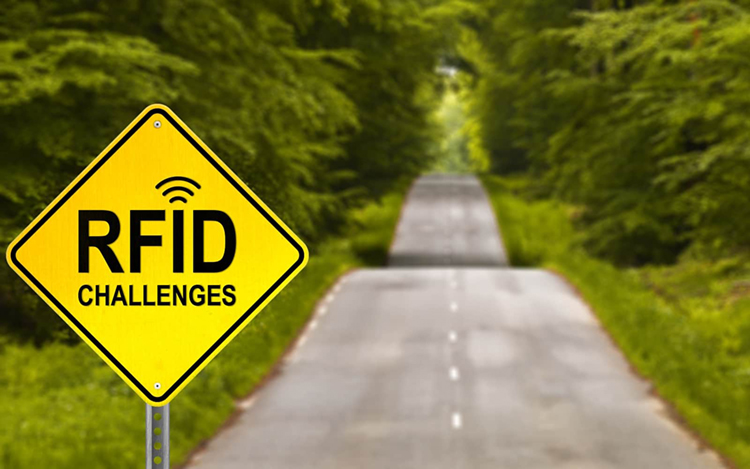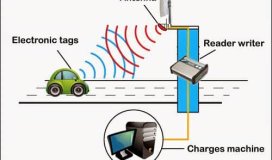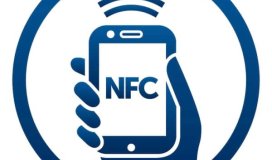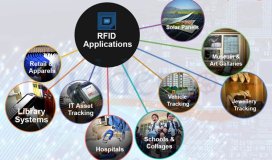Deploying an RFID application without consideration of the environment can potentially lead to thousands of dollars spent with less than stellar read rates. If positive results cannot be provided within the required timeframe, the project may be abandoned and the organization deprived of potential time and cost savings.
Whether the RF waves are absorbed (as with liquids) or reflected (as with metals), any source of interference in the environment may cause problems unless properly mitigated.
Liquids absorb RF energy.
What’s the Problem?
Tagging Liquid-Filled Containers
In the past, it was nearly impossible to tag liquid-filled containers because the absorption of RF energy by the liquid would leave little RF energy for the RFID tag to receive, much less to backscatter in reply to the RFID reader. Now, there are quite a few options for tagging liquid-filled containers.
How can you mitigate it?
Option: Use Low Frequency (LF) RFID instead of High or Ultra-High Frequency. LF RFID does not have the issues with water that higher frequencies struggle with, so it can be used for animal tracking or water-filled items. The downside is slower data transmission speeds and shorter read ranges relative to the higher frequencies.
Option: Use UHF labels approved specifically for use on water-filled containers like the Omni-ID IQ 600 Labels and the Confidex Silverline.
Option: Use UHF Near-Field tags approved for use on water-filled containers like the Alien SIT tag and the SMARTRAC Trap.
Option: Use regular UHF inlays or labels and place a spacer between the liquid and the tag made from foam, silicon, or another thick material (e.g. the Foam-Backed ShortDipole).

What’s the Problem?
Tagging Items in Liquids
Impossible with UHF until a few years ago, tagging items in liquids can now be done thanks to the better tag construction and design.
How can you mitigate it?
Option: Use Low Frequency (LF) RFID instead of High or Ultra-High Frequency. LF RFID does not have the issues with water that higher frequencies struggle with, so it can be used for animal tracking or water-filled items. Again, the downside is slower data transmission speeds and shorter read ranges relative to the higher frequencies.
Option: Use UHF Near-Field tags approved for use in water-filled containers like the Alien SIT tag. The read range will be very short, but these tags will still read. NOTE: there is no guarantee that this will work consistently for an application; testing is always key.
What’s the Problem?
Liquid in the Environment
Whether the application is outdoors near lakes or ponds, or indoors around water tanks or water-filled machinery, liquid can play a role in an RFID application because it absorbs RF energy.
How can you mitigate it?
Option: Use Low Frequency (LF) RFID instead of High or Ultra-High Frequency. LF RFID does not have the issues with water that higher frequencies struggle with, so it can be used for animal tracking or water-filled items. Again, the downside is slower data transmission speeds and shorter read ranges relative to the higher frequencies.
Option: Set up the RFID system with extra hardware to ensure that the necessary RF energy gets to the tagged objects and not significantly absorbed by the liquid. RFID Power Mappers are a great tool for measuring UHF RF energy in any given area and determining if enough energy is reaching the designated read zone.

Metal reflects RF waves.
What’s the Problem?
Tagging Metal Objects
How can you mitigate it?
Option: Use metal-mount RFID tags which are produced specifically for tagging metal surfaces. Examples of metal-mount tags are the Omni-ID Exo 750, Xerafy Micro XII, and the Vulcan Custom Universal Asset Tag.
Option: Place an embeddable, metal-mount tag into a drilled or pre-made hole in the object. In some applications, embedding works even better than adhering on the object (such as in rugged environments). When embedding an RFID tag, always leave one side with no metal covering and protect it with epoxy or something similar to ensure it can be read. (NOTE: an RFID tag completely encased in metal cannot be read).
What’s the Problem?
Metal in the Environment
Metal in the environment reflects RF waves, potentially creating null zones where the RFID tag cannot be detected. More metal in an environment will lead to an increased number reflections, ultimately causing multiple null zones.
How can you mitigate it?
Option: Place RF absorbing materials in front of metal objects to absorb the RF waves instead of reflecting them back into the environment. RF absorbing materials can be substances like carbon-loaded foam and polyurethane foam.
Option: Set up the system with extra hardware to ensure that the necessary RF energy gets to the tagged objects. RFID Power Mappers are a great tool for measuring UHF RF energy in any given area and determining if enough energy is reaching the designated read zone.



